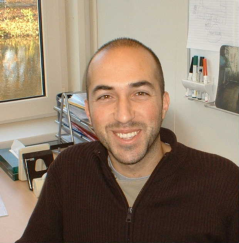Calix[4]arene Metal Complexes as Nuclease and Transacylase Mimics
Promotion Date: 25 November 2004
| A calixarene is a ring shaped molecule. On this molecule one, two or three ligands able to bind metal ions were attached. Nucleases and Transacylases are hydrolytic enzymes that exploit metal ions in the catalytic process. The idea was to make a calixarene structure able to mimic the catalytic activity of these enzymes. The aim is to produce a molecule that can selectively recognize and cleave the RNA. In the DNA we stock the genetic information. The DNA gives the genetic information of how to produce all the proteins in the body. |
What was your thesis about?
A calixarene is a ring shaped molecule. On this molecule one, two or three ligands able to bind metal ions were attached. Nucleases and Transacylases are hydrolytic enzymes that exploit metal ions in the catalytic process. The idea was to make a calixarene structure able to mimic the catalytic activity of these enzymes.
Why would you want to mimic them?
The aim is to produce a molecule that can selectively recognize and cleave the RNA.
In the DNA we stock the genetic information. The DNA gives the genetic information of how to produce all the proteins in the body. In order to this, the DNA transfers these information to the RNA, which is the messenger of the genetic information. When there is a genetic disease, the DNA has a wrong base sequence, and as a consequence the RNA carries wrong information. So if we could produce a nuclease mimic that recognises the wrong RNA, it could cut it in order to prevent the synthesis of the wrong proteins. We are far from this as yet, but this is the reason behind the research.
This was a joint project?
Yes, it was a collaboration between three universities: University of Twente, University of Parma and University of Rome. I only spent a short time at the University of Rome and have been one year at this university.
Did you like being here?
Yes, I enjoyed it. There are people from all other countries, so I did not have great difficulty of fitting in. A had a room in Enschede in a house in a pleasant environment with a garden and so on. That was also nice.
What did you like best about your research?
I liked the international experience best. It was very nice to work with so may people from so many different backgrounds. You encounter different ways of working and different skills.
So learn a lot from that. I liked the last part of the research a lot, when I performed the measurements in the biochemistry department. I joined the biochemical group and that again was a different way of working. I learned how to manage the RNA and how to work in a sterile environment.
Was there anything that you did not like?
Well, not really. Perhaps it was a bit too busy at times. In the first year I did not get many results and that produces stress of course. But now, looking back, I think that even this is part of the experience. I liked the work and it is quite normal that you do not get that many results in your first year. The most productive years of a PhD research are usually the third and fourth year.
What are you going to do next?
I have a fellowship at the University of Parma, but only for a few months. I’d like to finish a part of the work that I did not get round to doing in my PhD. Then there is a chance that I will get position of four years at the Pharmaceutical Department of the University of Parma and perhaps after that something even more permanent. I would like to stay at university, but at the moment there is a reform of the Italian university, and the permanency will be very uncertain. There is the risk, that if after four other years I cannot stay at the university, I will have a problem in finding a job in industry. By that time I will be 34 and at this age in Italy you are considered old for a first employment.
For the summary of the thesis, click here.

